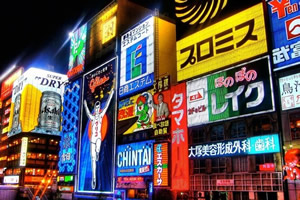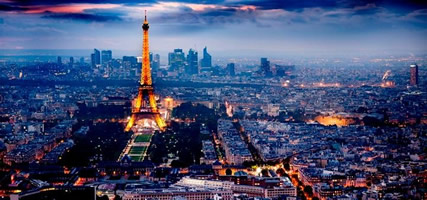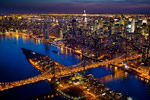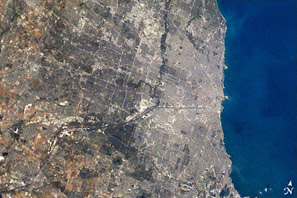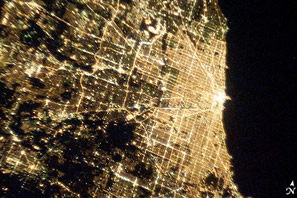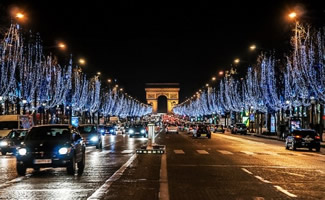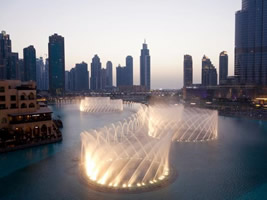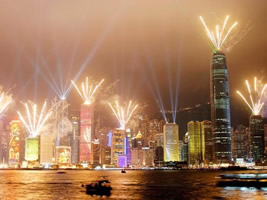The Cities of Lights: A Century of Optics in LEDs, NEON and Light
The Cities of Lights: A Century of Optics in LEDs, NEON and Light
Tracy Schario
Think about the world’s greatest travel destinations – London. Dubai. New York City. Tokyo. Now picture them dark. Would any of these places be the same without light? The Optical Society (OSA), a global association of scientists and engineers who make lasers, sensors, cameras, LED, virtual reality and many other technologies possible, is celebrating its 100th birthday. One of the most common applications of the science of light (aka optics and photonics) is – well – light.
Neon signs, for example – be it those flashing ads in Las Vegas or Osaka or the “open” sign at a bar – were revolutionary at the turn of the last century. The first neon gas signs were designed by OSA Founder Perley Nutting while he was at the National Bureau of Standards in Washington, DC, and he demonstrated them in 1904 at the World’s Fair in St. Louis, Missouri, USA.
Paris, France, may be the city most commonly referred to as the “City of Lights,” but in reality, nearly all of the world’s top travel destinations are popular thanks to attractions accentuated by light. Travel across the globe with us - from Las Vegas to Hong Kong - as we explore the light-based attractions in your favorite cities.
“We take light for granted, but it powers so much of modern life – telecommunications, energy, manufacturing, security,” said Dr. Gregory Quarles, chief scientist at The Optical Society. “We could survive without neon signs (I think), but image your life without the internet, cheap or free international phone calls, Lasik eye surgery, telescopes, cameras, X-Rays and lasers. It would be a primitive existence. Optics has brought new revolutions to manufacturing, biomedicine, agriculture, entertainment and many other sectors.”
The Americas
In 2008, NASA highlighted the role light plays in our cities by releasing photographs of the planet at night. It’s no surprise that viewed from space, the flashing, colorful lights that adorn the strip in Las Vegas make it the brightest city on Earth. Known as one of the top cities for nightlife, casinos and entertainment, Sin City’s skyline is illuminated by millions of lights, keeping its top attractions shining brightly all night long.
Speaking of nightlife, New York City, or, more aptly, the “City that Never Sleeps,” is another American destination that is known for its distinctive well-lit skyline. According to the New York City Department of Transportation (DOT), the city maintains more than 250,000 street lights. The City that Never Sleeps is also a national leader in sustainable street lighting: the DOT is currently retrofitting all of the city’s lights with energy-efficient LEDs that will save $6 million in energy and $8 million in maintenance each year – the largest project of its kind in the U.S
Chicago, another major U.S. travel destination, is a sprawling metropolis home to nearly 3 million people (with the wider metropolitan area including nearly 10 million). In these photos taken by NASA, you can see the importance of light to the massive population when the sun goes down.
In San Francisco, there’s no missing the Bay Lights, an iconic light sculpture designed by world-renowned artist Leo Villareal. The lights shine from dusk until dawn on the San Francisco Bay Bridge.
Europe, Asia & Beyond
London is known for more than just its cloudy skies and rich history. Each year, the city’s most famous attractions, from Big Ben to the London Eye Ferris wheel, provide the backdrop to an impressive New Year’s firework display. In 2014, London had the world's first multi-sensory fireworks show, marked by colored, fiber optics-powered fireworks matched with clouds of strawberry and banana flavored confetti. Incredible!
{^youtubevideo|(width)425|(height)264|(rel)False|(autoplay)False|(fs)True|(url)https://www.youtube.com/watch?v=NlNfrdXkbx8|(loop)False^}
Paris was one of the first cities to have street lights in the 1880s, lending it the early nickname, the “City of Lights.” Today, Paris offers tourists far more than its delicious cuisine and premier fashion houses. Did you know that more than 296 sites in Paris are illuminated? This includes hotels, churches, statues, fountains, national buildings and monuments. And then there’s the stunning Eiffel Tower, which is strung with 40 km of illuminated garlands made up of nearly half a million sparkling light bulbs. Meanwhile, the Champs-Elysées lights up for the Christmas illuminations with 2.4 km of lights and 450 decorated trees.
In Dubai, U.A.E., The Dubai Fountain – set against the great Burj Khalifa Lake – offers tourists a mesmerizing series of lights and graceful water jets. The fountain is illuminated by more than 6,600 WET Superlights, making it the most advanced incandescent light fountain in the world. It isn’t entirely surprising, then, that the fountain shines so brightly that it can be seen from space at night.
When thinking about magnificent displays of lights in world-class cities, one can’t skip over Sydney, Australia, where the Laser-Dragon Water-Theater brings ins thousands of tourists each year, with its “four video projected water-screens, forty 20m-high vertical fountains, sixteen 25m-high moving fountains, twenty-two 15m-high flame jets and ten powerful lasers.”
The final city we’ll explore is Hong Kong. Millions of tourists flock to Hong Kong for its variety of futuristic skyscrapers and traditional Chinese temples. What’s more, the “Symphony of Lights” laser show boasts the entire Hong Kong skyline as its backdrop. According to the Travel Channel, the 13-minute nightly show is divided into five parts, building excitement slowly until the tops of the skyscrapers erupt with radiance.
From illuminating the sparkling Eiffel Tower to fueling the magnificent New Year’s fireworks show in London, light – and the power of optics – creates memorable experiences for tourists around the globe. As we take this year to reflect on The Optical Society’s 100th birthday, we thank the optical scientists who have advanced the applications of light with discovery of the laser to the development of energy-efficient bulbs; their work will forever light our world.
